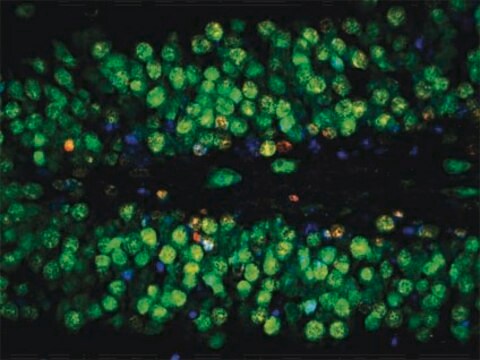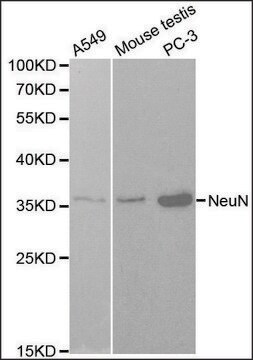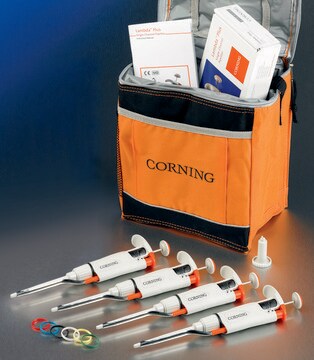추천 제품
생물학적 소스
mouse
Quality Level
결합
PE
항체 형태
purified immunoglobulin
항체 생산 유형
primary antibodies
클론
A60, monoclonal
종 반응성
human
제조업체/상표
Milli-Mark®
기술
flow cytometry: suitable
동형
IgG1
배송 상태
wet ice
타겟 번역 후 변형
unmodified
유전자 정보
human ... RBFOX3(146713)
관련 카테고리
일반 설명
NeuN antibody (NEUronal Nuclei; clone A60) specifically recognizes the DNA-binding, neuron-specific protein NeuN, which is present in most CNS and PNS neuronal cell types of all vertebrates tested. NeuN protein distributions are apparently restricted to neuronal nuclei, perikarya and some proximal neuronal processes in both fetal and adult brain although, some neurons fail to be recognized by NeuN at all ages: INL retinal cells, Cajal-Retzius cells, Purkinje cells, inferior olivary and dentate nucleus neurons, and sympathetic ganglion cells are examples (Mullen et al., 1992; Wolf et al., 1996). Immunohistochemically detectable NeuN protein first appears at developmental timepoints that correspond with the withdrawal of the neuron from the cell cycle and/or with the initiation of terminal differentiation of the neuron (Mullen et al., 1992). Immunoreactivity appears around E9.5 in the mouse neural tube and is extensive throughout the developing nervous system by E12.5.
특이성
Antibody recognizes Neuronal Nuclei.
면역원
Purified cell nuclei from mouse brain.
애플리케이션
Research Category
Neuroscience
Neuroscience
Research Sub Category
Neuronal & Glial Markers
Neuronal & Glial Markers
This Milli-Mark Anti-NeuN-PE Antibody, clone A60 is validated for use in FC for the detection of NeuN.
품질
Evaluated by flow cytometry using U251 cells.
물리적 형태
Protein A purified
Purified mouse monoclonal IgG1 conjugated to PE in PBS with 0.1% sodium azide and 15 mg/mL BSA
저장 및 안정성
Maintain refrigerated at 2-8 °C protected from light in undiluted aliquots for up to 6 months from date of receipt.
분석 메모
Control
U251 cells
U251 cells
법적 정보
MILLI-MARK is a registered trademark of Merck KGaA, Darmstadt, Germany
면책조항
Unless otherwise stated in our catalog or other company documentation accompanying the product(s), our products are intended for research use only and are not to be used for any other purpose, which includes but is not limited to, unauthorized commercial uses, in vitro diagnostic uses, ex vivo or in vivo therapeutic uses or any type of consumption or application to humans or animals.
적합한 제품을 찾을 수 없으신가요?
당사의 제품 선택기 도구.을(를) 시도해 보세요.
Storage Class Code
10 - Combustible liquids
WGK
WGK 2
Flash Point (°F)
Not applicable
Flash Point (°C)
Not applicable
시험 성적서(COA)
제품의 로트/배치 번호를 입력하여 시험 성적서(COA)을 검색하십시오. 로트 및 배치 번호는 제품 라벨에 있는 ‘로트’ 또는 ‘배치’라는 용어 뒤에서 찾을 수 있습니다.
Julio Barrera et al.
Molecular neurodegeneration, 16(1), 58-58 (2021-08-26)
In the post-GWAS era, there is an unmet need to decode the underpinning genetic etiologies of late-onset Alzheimer's disease (LOAD) and translate the associations to causation. We conducted ATAC-seq profiling using NeuN sorted-nuclei from 40 frozen brain tissues to determine
Alexey Kozlenkov et al.
Science advances, 4(9), eaau6190-eaau6190 (2018-09-29)
Brain function depends on interaction of diverse cell types whose gene expression and identity are defined, in part, by epigenetic mechanisms. Neuronal DNA contains two major epigenetic modifications, methylcytosine (mC) and hydroxymethylcytosine (hmC), yet their cell type-specific landscapes and relationship
Boxun Zhao et al.
PLoS genetics, 15(4), e1008043-e1008043 (2019-04-12)
Mounting evidence supports that LINE-1 (L1) retrotransposition can occur postzygotically in healthy and diseased human tissues, contributing to genomic mosaicism in the brain and other somatic tissues of an individual. However, the genomic distribution of somatic human-specific LINE-1 (L1Hs) insertions
Kathryn Vaillancourt et al.
iScience, 24(10), 103169-103169 (2021-10-26)
Cocaine dependence is a chronic, relapsing disorder caused by lasting changes in the brain. Animal studies have identified cocaine-related alterations in striatal DNA methylation; however, it is unclear how methylation is related to cocaine dependence in humans. We generated methylomic
Jeffrey Gu et al.
Frontiers in neuroscience, 15, 652226-652226 (2021-05-18)
Parkinson's disease (PD) and dementia with Lewy body (DLB) are the most common synucleinopathies. SNCA gene is a major genetic risk factor for these diseases group, and dysregulation of its expression has been implicated in the genetic etiologies of several
자사의 과학자팀은 생명 과학, 재료 과학, 화학 합성, 크로마토그래피, 분석 및 기타 많은 영역을 포함한 모든 과학 분야에 경험이 있습니다..
고객지원팀으로 연락바랍니다.








